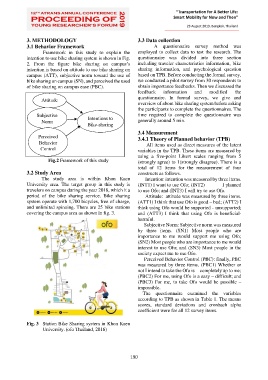Page 215 - Proceeding of Atrans Young Researcher's Forum 2019_Neat
P. 215
“Transportation for A Better Life:
Smart Mobility for Now and Then”
23 August 2019, Bangkok, Thailand
3. METHODOLOGY 3.3 Data collection
3.1 Behavior Framework A questionnaire survey method was
Framework in this study to explain the employed to collect data to test the research. The
intention to use bike sharing system is shown in Fig. questionnaire was divided into three section
2. From the figure bike sharing on campus’s including traveler characteristics information, bike
intention is based on attitude to use bike sharing on sharing information, and psychological question
campus (ATT), subjective norm toward the use of based on TPB. Before conducting the formal survey,
bike sharing on campus (SN), and perceived the used we conducted a pilot survey from 30 respondents to
of bike sharing on campus ease (PBC). obtain importance feedbacks. Then we discussed the
feedback information and modified the
Attitude questionnaire. In formal survey, we give and
overview of about bike sharing system before asking
the participants to complete the questionnaires. The
Subjective time required to complete the questionnaire was
Intentions to generally around 5 min.
Norm Bike-sharing
Perceived 3.4 Measurement
3.4.1 Theory of Planned behavior (TPB)
Behavior All items used as direct measures of the latent
Control variables in the TPB. These items are measured by
using a five-point Likert scales ranging from 5
Fig.2 Framework of this study (strongly agree) to 1(strongly disagree). There is a
total of 12 items for the measurement of four
3.2 Study Area constructs as follows.
The study area is within Khon Kaen Intention: intention was measured by three items.
University area. The target group in this study is (INT1) I want to use Ofo; (INT2) I planned
travelers on campus during the year 2018, which it a to use Ofo; and (INT3) I will try to use Ofo.
period of the bike sharing service. Bike sharing Attitude: attitude was measured by three items.
system operate with 1,700 bicycles, free of charge, (ATT1) I think that use Ofo is good – bad; (ATT2) I
and unlimited spinning. There are 25 bike stations think using Ofo would be supported - unsupported;
covering the campus area as shown In fig. 3. and (ATT3) I think that using Ofo is beneficial-
harmful.
Subjective Norm: Subjective norm was measured
by three items. (SN1) Most people who are
importance to me would support me using Ofo;
(SN2) Most people who are importance to me would
interest to use Ofo; and (SN3) Most people in the
society expect me to use Ofo.
Perceived Behavior Control (PBC): finally, PBC
was measured by three items. (PBC1) Whether or
not I intend to take the Ofo is completely up to me;
(PBC2) For me, using Ofo is a easy – difficult; and
(PBC3) For me, to take Ofo would be possible –
impossible.
The questionnaire examined the variables
according to TPB as shown in Table 1. The means
scores, standard deviations and cronbach alpha
coefficient were for all 12 survey items.
Fig. 3 Station Bike Sharing system in Khon Kaen
University. (ofo Thailand, 2016)
190

